Reconstructing the VOC–Ozone Research Framework Through a Systematic Review of Observation and Modeling
Abstract
1. Introduction
2. Mapping Methods and Knowledge Evolution in VOC–O3 Studies
2.1. Methodology
2.1.1. Data Sources
- (1)
- VOC species terms: e.g., “VOCs”, “NMHCs”, “BTEX”, “isoprene”, and “formaldehyde”;
- (2)
- Observation descriptors: e.g., “in-situ measurement”, “real-time analysis”, “profiling”, “remote sensing”, and “continuous sampling”;
- (3)
- Platform-specific identifiers: e.g., “air monitoring site”, “mobile laboratory,”, “Sentinel-5P”, and “drone-based VOC sampling”.
2.1.2. Tools
2.2. Knowledge Structure and Research Dynamics in the VOC–O3 Domain
2.2.1. The Changing Landscape of VOCs and Ozone Research
2.2.2. National Research Profiles and Structural Influence
2.2.3. Evolving Research Focus and Influential Contributions
3. Hierarchical Platforms and the Recursive Architecture of VOCs Observability
3.1. Recursive Sensing and the Architecture of VOCs Observability
3.2. Ground-Based Platforms for VOCs Monitoring

3.3. Airborne Platforms and Multi-Altitude VOC Detection
3.4. Satellite-Based VOCs Monitoring and Ozone Sensitivity Diagnostics
4. Technological Pathways for VOC Observation and Ozone Modeling
4.1. Nonlinear Mechanisms and Semi-Empirical Modeling of O3 Formation Sensitivity
4.2. Traditional Modeling Paradigms: From Observation-Based Inference to Chemical Transport Simulation
4.3. Remote Sensing-Based Inversion of Precursors and Modeling of Ozone Formation Mechanisms
4.4. Artificial Intelligence for Ozone Modeling: From Data-Driven Generalization to Mechanistic Inference
5. Discussions
5.1. Platform Interoperability and the Observation–Model Divide
5.2. Spatial Mismatch, Sensitivity Drift, and the Fragility of Predictive Modeling
5.3. Artificial Intelligence in VOC–O3 Modeling: Structural Capabilities, Functional Gaps, and Systemic Remedies
5.4. Toward Systemic Integration: From Structural Correction to Functional Governance
6. Conclusions
Author Contributions
Funding
Institutional Review Board Statement
Informed Consent Statement
Data Availability Statement
Conflicts of Interest
References
- Iturrate-Garcia, M.; Salameh, T.; Schlauri, P.; Baldan, A.; Vollmer, M.; Stratigou, E.; Dusanter, S.; Li, J.; Persijn, S.; Claude, A.; et al. Towards a High-Quality in Situ Observation Network for Oxygenated Volatile Organic Compounds (OVOCs) in Europe: Transferring Metrological Traceability to the Field. Atmos. Meas. Tech. 2025, 18, 371–403. [Google Scholar] [CrossRef]
- Lee, H.E.; Lee, B.-W.; Kim, J.H. Investigating VOCs Speciation Characteristics at the Fenceline of Synthetic Rubber Manufacturing Industries via Active and Passive Monitoring Techniques. Atmosphere 2023, 14, 1119. [Google Scholar] [CrossRef]
- Feng, S.; Jiang, F.; Qian, T.; Wang, N.; Jia, M.; Zheng, S.; Chen, J.; Ying, F.; Ju, W. Constraining Non-Methane VOC Emissions with TROPOMI HCHO Observations: Impact on Summertime Ozone Simulation in August 2022 in China. Atmos. Chem. Phys. 2024, 24, 7481–7498. [Google Scholar] [CrossRef]
- Choi, W.N.; Hong, H.K.; Lee, Y.W.; Ryu, J.Y.; Park, J.S.; Lee, H.L. First-Time Estimation of HCHO Column over Asia Using Multiple Regression with OMI and MODIS Data. J. Environ. Inform. 2019, 34, 88–98. [Google Scholar] [CrossRef]
- Lu, Y.; Wu, Z.; Pang, X.; Wu, H.; Xing, B.; Li, J.; Xiang, Q.; Chen, J.; Shi, D. Temporal Characteristics of Ozone (O3) in the Representative City of the Yangtze River Delta: Explanatory Factors and Sensitivity Analysis. Int. J. Environ. Res. Public Health 2023, 20, 168. [Google Scholar] [CrossRef] [PubMed]
- Zhang, J.; Wang, T.; Chameides, W.L.; Cardelino, C.; Kwok, J.; Blake, D.R.; Ding, A.; So, K.L. Ozone Production and Hydrocarbon Reactivity in Hong Kong, Southern China. Atmos. Chem. Phys. 2007, 7, 557–573. [Google Scholar] [CrossRef]
- Morfopoulos, C.; Muller, J.-F.; Stavrakou, T.; Bauwens, M.; De Smedt, I.; Friedlingstein, P.; Prentice, I.C.; Regnier, P. Vegetation Responses to Climate Extremes Recorded by Remotely Sensed Atmospheric Formaldehyde. Glob. Change Biol. 2022, 28, 1809–1822. [Google Scholar] [CrossRef]
- Wang, D.; Pu, D.; De Smedt, I.; Zhu, L.; Yang, X.; Sun, W.; Xia, H.; Song, Z.; Li, X.; Li, J.; et al. Evolution of Global O3-NOx-VOCs Sensitivity before and after the COVID-19 from the Ratio of Formaldehyde to NO2 from Satellite Observations. J. Environ. Sci. 2025, 156, 102–113. [Google Scholar] [CrossRef]
- Franco, B.; Clarisse, L.; Stavrakou, T.; Mueller, J.-F.; Van Damme, M.; Whitburn, S.; Hadji-Lazaro, J.; Hurtmans, D.; Taraborrelli, D.; Clerbaux, C.; et al. A General Framework for Global Retrievals of Trace Gases From IASI: Application to Methanol, Formic Acid, and PAN. J. Geophys. Res.-Atmos. 2018, 123, 13963–13984. [Google Scholar] [CrossRef]
- Palmer, P.; Jacob, D.; Fiore, A.; Martin, R.; Chance, K.; Kurosu, T. Mapping Isoprene Emissions over North America Using Formaldehyde Column Observations from Space. J. Geophys. Res.-Atmos. 2003, 108. [Google Scholar] [CrossRef]
- Du, X.; Tang, W.; Cheng, M.; Zhang, Z.; Li, Y.; Li, Y.; Meng, F. Modeling of Spatial and Temporal Variations of Ozone-NOX-VOC Sensitivity Based on Photochemical Indicators in China. J. Environ. Sci. 2022, 114, 454–464. [Google Scholar] [CrossRef]
- Zhao, F.; Liu, C.; Cai, Z.; Liu, X.; Bak, J.; Kim, J.; Hu, Q.; Xia, C.; Zhang, C.; Sun, Y.; et al. Ozone Profile Retrievals from TROPOMI: Implication for the Variation of Tropospheric Ozone during the Outbreak of COVID-19 in China. Sci. Total Environ. 2021, 764, 142886. [Google Scholar] [CrossRef]
- Leung, P.; Harrison, R. Roadside and In-Vehicle Concentrations of Monoaromatic Hydrocarbons. Atmos. Environ. 1999, 33, 191–204. [Google Scholar] [CrossRef]
- Qin, Y.; Tonnesen, G.; Wang, Z. Weekend/Weekday Differences of Ozone, NOx, Co, VOCs, PM10 and the Light Scatter during Ozone Season in Southern California. Atmos. Environ. 2004, 38, 3069–3087. [Google Scholar] [CrossRef]
- Mukherjee, A.; Agrawal, S.B.; Agrawal, M. Intra-Urban Variability of Ozone in a Tropical City-Characterization of Local and Regional Sources and Major Influencing Factors. Air Qual. Atmos. Health 2018, 11, 965–977. [Google Scholar] [CrossRef]
- Navazo, M.; Durana, N.; Alonso, L.; García, J.; Ilardia, J.; Gómez, M.; Gangoiti, G. Volatile Organic Compounds in Urban and Industrial Atmospheres:: Measurement Techniques and Data Analysis. Int. J. Environ. Anal. Chem. 2003, 83, 199–217. [Google Scholar] [CrossRef]
- Carpenter, L.; Lewis, A.; Hopkins, J.; Read, K.; Longley, I.; Gallagher, M. Uptake of Methanol to the North Atlantic Ocean Surface. Glob. Biogeochem. Cycles 2004, 18. [Google Scholar] [CrossRef]
- Kaminsky, J.; Wylie, A. Vertical contaminant profiling of volatile organics in a deep fractured basalt aquifer. Ground Water Monit. Remediat. 1995, 15, 97–103. [Google Scholar] [CrossRef]
- Shuaibu, N.S.; Qin, C.; Chu, F.; Ismail, B.B.; Ibrahim, A.M.; Indabawa, M.G.; Abdalmohammed, S.A.A.; Zhao, G.; Wang, X. Traceability Tagging of Volatile Organic Compound Sources and Their Contributions to Ozone Formation in Suzhou Using Vehicle-Based Portable Single-Photon Ionization Mass Spectrometry. Environ. Sci. Eur. 2024, 36, 46. [Google Scholar] [CrossRef]
- Kim, J.-H.; Lee, H.E.; Yoon, S.J. Study on the Speciation of VOCs at Oil Refining Plant Fenceline through Active Sampling. Atmosphere 2023, 14, 485. [Google Scholar] [CrossRef]
- Kim, M.-G.; Kim, J.H.; Yoon, S.J.; Cho, S.H.; Yu, J.U.; Kang, C.W.; Moon, K.W.; Lee, H.E. Evaluating the Feasibility of Air Environment Management System for VOCs through ‘VOCs Specification’ of Petroleum Refining Industry. J. Air Waste Manag. Assoc. 2023, 73, 362–373. [Google Scholar] [CrossRef]
- Andreae, M.O.; Acevedo, O.C.; Araujo, A.; Artaxo, P.; Barbosa, C.G.G.; Barbosa, H.M.J.; Brito, J.; Carbone, S.; Chi, X.; Cintra, B.B.L.; et al. The Amazon Tall Tower Observatory (ATTO): Overview of Pilot Measurements on Ecosystem Ecology, Meteorology, Trace Gases, and Aerosols. Atmos. Chem. Phys. 2015, 15, 10723–10776. [Google Scholar] [CrossRef]
- Li, L.; Lu, C.; Chan, P.-W.; Lan, Z.; Zhang, W.; Yang, H.; Wang, H. Impact of the COVID-19 on the Vertical Distributions of Major Pollutants from a Tower in the Pearl River Delta. Atmos. Environ. 2022, 276, 119068. [Google Scholar] [CrossRef] [PubMed]
- Luo, H.; Li, G.; Chen, J.; Wang, Y.; An, T. Reactor Characterization and Primary Application of a State of Art Dual-Reactor Chamber in the Investigation of Atmospheric Photochemical Processes. J. Environ. Sci. 2020, 98, 161–168. [Google Scholar] [CrossRef] [PubMed]
- Wegener, R.; Brauers, T.; Koppmann, R.; Rodriguez Bares, S.; Rohrer, F.; Tillmann, R.; Wahner, A.; Hansel, A.; Wisthaler, A. Simulation Chamber Investigation of the Reactions of Ozone with Short-Chained Alkenes. J. Geophys. Res.-Atmos. 2007, 112. [Google Scholar] [CrossRef]
- Kaiser, J.; Li, X.; Tillmann, R.; Acir, I.; Holland, F.; Rohrer, F.; Wegener, R.; Keutsch, F.N. Intercomparison of Hantzsch and Fiber-Laser-Induced-Fluorescence Formaldehyde Measurements. Atmos. Meas. Tech. 2014, 7, 1571–1580. [Google Scholar] [CrossRef]
- Zogka, A.G.; Mellouki, A.; Romanias, M.N.; Bedjanian, Y.; Idir, M.; Grosselin, B.; Daele, V. Atmospheric Chemistry of 1-Methoxy 2-Propyl Acetate: UV Absorption Cross Sections, Rate Coefficients, and Products of Its Reactions with OH Radicals and CI Atoms. J. Phys. Chem. A 2016, 120, 9049–9062. [Google Scholar] [CrossRef]
- Pusfitasari, E.D.; Ruiz-Jimenez, J.; Tiusanen, A.; Suuronen, M.; Haataja, J.; Wu, Y.; Kangasluoma, J.; Luoma, K.; Petajae, T.; Jussila, M.; et al. Vertical Profiles of Volatile Organic Compounds and Fine Particles Inatmospheric Air by Using an Aerial Drone with Miniaturized Samplers Andportable Devices. Atmos. Chem. Phys. 2023, 23, 5885–5904. [Google Scholar] [CrossRef]
- Liang, C.-W.; Zheng, Z.-C.; Chen, T.-N. Monitoring Landfill Volatile Organic Compounds Emissions by an Uncrewed Aerial Vehicle Platform with Infrared and Visible-Light Cameras, Remote Monitoring, and Sampling Systems. J. Environ. Manag. 2024, 365, 121575. [Google Scholar] [CrossRef]
- Cheng, W.-H.; Yuan, C.-S. Identification of Emission Source Using a Micro Sampler Carried by a Drone. Drones 2022, 6, 116. [Google Scholar] [CrossRef]
- Kluge, F.; Hueneke, T.; Knecht, M.; Lichtenstern, M.; Rotermund, M.; Schlager, H.; Schreiner, B.; Pfeilsticker, K. Profiling of Formaldehyde, Glyoxal, Methylglyoxal, and CO over the Amazon: Normalized Excess Mixing Ratios and Related Emission Factors in Biomass Burning Plumes. Atmos. Chem. Phys. 2020, 20, 12363–12389. [Google Scholar] [CrossRef]
- Ashworth, K.; Bucci, S.; Gallimore, P.J.; Lee, J.; Nelson, B.S.; Sanchez-Marroquin, A.; Schimpf, M.B.; Smith, P.D.; Drysdale, W.S.; Hopkins, J.R.; et al. Megacity and Local Contributions to Regional Air Pollution: An Aircraft Case Study over London. Atmos. Chem. Phys. 2020, 20, 7193–7216. [Google Scholar] [CrossRef]
- Borbon, A.; Ruiz, M.; Bechara, J.; Aumont, B.; Chong, M.; Huntrieser, H.; Mari, C.; Reeves, C.E.; Scialom, G.; Hamburger, T.; et al. Transport and Chemistry of Formaldehyde by Mesoscale Convective Systems in West Africa during AMMA 2006. J. Geophys. Res.-Atmos. 2012, 117. [Google Scholar] [CrossRef]
- Yang, S.; Zhu, B.; Shi, S.; Jiang, Z.; Hou, X.; An, J.; Xia, L. Vertical Features of Volatile Organic Compounds and Their Potential Photochemical Reactivities in Boundary Layer Revealed by In-Situ Observations and Satellite Retrieval. Remote Sens. 2024, 16, 1403. [Google Scholar] [CrossRef]
- Surl, L.; Palmer, P.I.; Abad, G.G. Which Processes Drive Observed Variations of HCHO Columns over India? Atmos. Chem. Phys. 2018, 18, 4549–4566. [Google Scholar] [CrossRef]
- Franco, B.; Clarisse, L.; Van Damme, M.; Hadji-Lazaro, J.; Clerbaux, C.; Coheur, P. Satellite-Based Identification of Large Anthropogenic NMVOC Emission Sources. J. Geophys. Res.-Atmos. 2024, 129, e2024JD042047. [Google Scholar] [CrossRef]
- Zeng, Z.-C.; Franco, B.; Clarisse, L.; Lee, L.; Qi, C.; Lu, F. Observing a Volatile Organic Compound From a Geostationary Infrared Sounder: HCOOH From FengYun-4B/GIIRS. J. Geophys. Res.-Atmos. 2024, 129, e2024JD041352. [Google Scholar] [CrossRef]
- Tie, X.; Chandra, S.; Ziemke, J.R.; Granier, C.; Brasseur, G.P. Satellite Measurements of Tropospheric Column O3 and NO2 in Eastern and Southeastern Asia:: Comparison with a Global Model (MOZART-2). J. Atmos. Chem. 2007, 56, 105–125. [Google Scholar] [CrossRef]
- Chua, G.; Naik, V.; Horowitz, L.W. Exploring the Drivers of Tropospheric Hydroxyl Radical Trends in the Geophysical Fluid Dynamics Laboratory AM4.1 Atmospheric Chemistry-Climate Model. Atmos. Chem. Phys. 2023, 23, 4955–4975. [Google Scholar] [CrossRef]
- De Smedt, I.; Stavrakou, T.; Muller, J.-F.; van der A, R.J.; Van Roozendael, M. Trend Detection in Satellite Observations of Formaldehyde Tropospheric Columns. Geophys. Res. Lett. 2010, 37, 11217. [Google Scholar] [CrossRef]
- Vrekoussis, M.; Wittrock, F.; Richter, A.; Burrows, J.P. Temporal and Spatial Variability of Glyoxal as Observed from Space. Atmos. Chem. Phys. 2009, 9, 4485–4504. [Google Scholar] [CrossRef]
- Wallace, H.W.; Jobson, B.T.; Erickson, M.H.; McCoskey, J.K.; VanReken, T.M.; Lamb, B.K.; Vaughan, J.K.; Hardy, R.J.; Cole, J.L.; Strachan, S.M.; et al. Comparison of Wintertime CO to NOx Ratios to MOVES and MOBILE6.2 on-Road Emissions Inventories. Atmos. Environ. 2012, 63, 289–297. [Google Scholar] [CrossRef]
- Afshari, A.; Schuch, F.; Marpu, P. Estimation of the Traffic Related Anthropogenic Heat Release Using BTEX Measurements—A Case Study in Abu Dhabi. Urban Clim. 2018, 24, 311–325. [Google Scholar] [CrossRef]
- Kodymova, J.; Petrvalska, R. Modeling of air pollution from traffic and comparison with automated station of air pollution monitoring. Energy Clean Technol. 2015, 4, 961–968. [Google Scholar]
- Cheng, N.; Li, R.; Xu, C.; Chen, Z.; Chen, D.; Meng, F.; Cheng, B.; Ma, Z.; Zhuang, Y.; He, B.; et al. Ground Ozone Variations at an Urban and a Rural Station in Beijing from 2006 to 2017: Trend, Meteorological Influences and Formation Regimes. J. Clean. Prod. 2019, 235, 11–20. [Google Scholar] [CrossRef]
- Kang, S.; Kim, J.-A.; Lee, M.; Park, J.; Jeon, E.; Shim, M.; Shin, Y. An Analysis of the Temporal Variability in Volatile Organic Compounds (VOCs) within Megacity Seoul and an Identification of Their Sources. Atmos. Pollut. Res. 2022, 13, 101338. [Google Scholar] [CrossRef]
- Ho, K.; Lee, S. Identification of Atmospheric Volatile Organic Compounds (VOCs), Polycyclic Aromatic Hydrocarbons (PAHs) and Carbonyl Compounds in Hong Kong. Sci. Total Environ. 2002, 289, 145–158. [Google Scholar] [CrossRef]
- Khan, A.; Szulejko, J.E.; Kim, K.-H.; Brown, R.J.C. Airborne Volatile Aromatic Hydrocarbons at an Urban Monitoring Station in Korea from 2013 to 2015. J. Environ. Manag. 2018, 209, 525–538. [Google Scholar] [CrossRef] [PubMed]
- Wagner, R.L.; Farren, N.J.; Davison, J.; Young, S.; Hopkins, J.R.; Lewis, A.C.; Carslaw, D.C.; Shaw, M.D. Application of a Mobile Laboratory Using a Selected-Ion Flow-Tube Mass Spectrometer (SIFT-MS) for Characterisation of Volatile Organic Compounds and Atmospheric Trace Gases. Atmos. Meas. Tech. 2021, 14, 6083–6100. [Google Scholar] [CrossRef]
- Herndon, S.; Jayne, J.; Zahniser, M.; Worsnop, D.; Knighton, B.; Alwine, E.; Lamb, B.; Zavala, M.; Nelson, D.; McManus, J.; et al. Characterization of Urban Pollutant Emission Fluxes and Ambient Concentration Distributions Using a Mobile Laboratory with Rapid Response Instrumentation. Faraday Discuss. 2005, 130, 327–339. [Google Scholar] [CrossRef]
- Hu, L.; Millet, D.B.; Baasandorj, M.; Griffis, T.J.; Turner, P.; Helmig, D.; Curtis, A.J.; Hueber, J. Isoprene Emissions and Impacts over an Ecological Transition Region in the US Upper Midwest Inferred from Tall Tower Measurements. J. Geophys. Res.-Atmos. 2015, 120, 3553–3571. [Google Scholar] [CrossRef]
- Kim, M.-G.; Lee, J.Y.; Kim, J.H.; Lee, H.E.; Cho, S.H.; Yu, J.U.; Kang, C.W.; Moon, K.W. Study of Chemical Substances Emitted during Paint Manufacturing through VOC Speciation. Atmosphere 2022, 13, 1245. [Google Scholar] [CrossRef]
- Hohaus, T.; Kuhn, U.; Andres, S.; Kaminski, M.; Rohrer, F.; Tillmann, R.; Wahner, A.; Wegener, R.; Yu, Z.; Kiendler-Scharr, A. A New Plant Chamber Facility, PLUS, Coupled to the Atmosphere Simulation Chamber SAPHIR. Atmos. Meas. Tech. 2016, 9, 1247–1259. [Google Scholar] [CrossRef]
- Yi, H.; Meng, L.; Wu, T.; Lauraguais, A.; Coeur, C.; Tomas, A.; Fu, H.; Gao, X.; Chen, W. Absolute Determination of Chemical Kinetic Rate Constants by Optical Tracking the Reaction on the Second Timescale Using Cavity-Enhanced Absorption Spectroscopy. Phys. Chem. Chem. Phys. 2022, 24, 7396–7404. [Google Scholar] [CrossRef] [PubMed]
- Cai, M.; Ren, Y.; Gibilisco, R.G.; Grosselin, B.; McGillen, M.R.; Xue, C.; Mellouki, A.; Daele, V. Ambient BTEX Concentrations during the COVID-19 Lockdown in a Peri-Urban Environment (Orleans, France). Atmosphere 2022, 13, 10. [Google Scholar] [CrossRef]
- France, J.L.; Bateson, P.; Dominutti, P.; Alen, G.; Andrews, S.; Bauguitte, S.; Coleman, M.; Lachlan-Cope, T.; Fisher, R.E.; Huang, L.; et al. Facility Level Measurement of Offshore Oil and Gas Installations from a Medium-Sized Airborne Platform: Method Development for Quantification and Source Identification of Methane Emissions. Atmos. Meas. Tech. 2021, 14, 71–88. [Google Scholar] [CrossRef]
- Cheng, W.-H.; Lin, C.-H.; Yuan, C.-S. VOC Sampler on a Drone Assisting in Tracing the Potential Sources by a Dispersion Model-Case Study of Industrial Emissions. Aerosol Air Qual. Res. 2023, 23, 71–88. [Google Scholar] [CrossRef]
- Li, Y.; Liu, B.; Ye, J.; Jia, T.; Khuzestani, R.B.; Sun, J.Y.; Cheng, X.; Zheng, Y.; Li, X.; Wu, C.; et al. Unmanned Aerial Vehicle Measurements of Volatile Organic Compounds over a Subtropical Forest in China and Implications for Emission Heterogeneity. ACS Earth Space Chem. 2021, 5, 247–256. [Google Scholar] [CrossRef]
- Hopkins, J.R.; Boddy, R.K.; Hamilton, J.F.; Lee, J.D.; Lewis, A.C.; Purvis, R.M.; Watson, N.J. An Observational Case Study of Ozone and Precursors Inflow to South East England during an Anticyclone. J. Environ. Monit. 2006, 8, 1195–1202. [Google Scholar] [CrossRef]
- Jin, X.; Fiore, A.M.; Murray, L.T.; Valin, L.C.; Lamsal, L.N.; Duncan, B.; Folkert Boersma, K.; De Smedt, I.; Abad, G.G.; Chance, K.; et al. Evaluating a Space-Based Indicator of Surface Ozone-NOx-VOC Sensitivity Over Midlatitude Source Regions and Application to Decadal Trends. J. Geophys. Res.-Atmos. 2017, 122, 10231–10253. [Google Scholar] [CrossRef]
- Qi, H.; Duan, W.; Cheng, S.; Huang, Z.; Hou, X. Research on Regional Ozone Prevention and Control Strategies in Eastern China Based on Pollutant Transport Network and FNR. Sci. Total Environ. 2024, 918, 170486. [Google Scholar] [CrossRef]
- Chen, K.; Wei, W.; Zhou, C.; Chen, S.; Wang, X.; Cheng, S. Spatiotemporal Mapping of Atmospheric Aldehydes over Beijing in Summer during 2019-2021 via Their Source Apportionment Study. Atmos. Res. 2023, 288, 106723. [Google Scholar] [CrossRef]
- Bauwens, M.; Stavrakou, T.; Müller, J.; De Smedt, I.; Van Roozendael, M.; van der Werf, G.; Wiedinmyer, C.; Kaiser, J.; Sindelarova, K.; Guenther, A. Nine Years of Global Hydrocarbon Emissions Based on Source Inversion of OMI Formaldehyde Observations. Atmos. Chem. Phys. 2016, 16, 10133–10158. [Google Scholar] [CrossRef]
- Barrese, E.; Valentini, M.; Scarpelli, M.; Samele, P.; Malacaria, L.; D’Amico, F.; Lo Feudo, T. Assessment of Formaldehyde’s Impact on Indoor Environments and Human Health via the Integration of Satellite Tropospheric Total Columns and Outdoor Ground Sensors. Sustainability 2024, 16, 9669. [Google Scholar] [CrossRef]
- Barret, B.; Medina, P.; Brett, N.; Pohorsky, R.; Law, K.S.; Bekki, S.; Fochesatto, G.J.; Schmale, J.; Arnold, S.R.; Baccarini, A.; et al. Surface Distributions and Vertical Profiles of Trace Gases (CO, O3, NO, NO2) in the Arctic Wintertime Boundary Layer Using Low-Cost Sensors during ALPACA-2022. Atmos. Meas. Tech. 2025, 18, 1163–1184. [Google Scholar] [CrossRef]
- Ren, J.; Guo, F.; Xie, S. Diagnosing Ozone-NOx-VOC Sensitivity and Revealing Causes of Ozoneincreases in China Based on 2013-2021 Satellite Retrievals. Atmos. Chem. Phys. 2022, 22, 15035–15047. [Google Scholar] [CrossRef]
- Alvarado, L.M.A.; Richter, A.; Vrekoussis, M.; Hilboll, A.; Hedegaard, A.B.K.; Schneising, O.; Burrows, J.P. Unexpected Long-Range Transport of Glyoxal and Formaldehyde Observed from the Copernicus Sentinel-5 Precursor Satellite during the 2018 Canadian Wildfires. Atmos. Chem. Phys. 2020, 20, 2057–2072. [Google Scholar] [CrossRef]
- Moradi, A.; Abera, T.A.; Shayle, E.S.; Muhammed, M.A.; Zeuss, D. Modeling Long-Term Dynamics of Biogenic Volatile Organic Compounds (BVOCs) in Germany Based on Major Precursors. Environ. Sci. Technol. 2025, 59, 4587–4596. [Google Scholar] [CrossRef]
- Acdan, J.J.M.; Pierce, R.B.; Dickens, A.F.; Adelman, Z.; Nergui, T. Examining TROPOMI Formaldehyde to Nitrogen Dioxide Ratios in the Lake Michigan Region: Implications for Ozone Exceedances. Atmos. Chem. Phys. 2023, 23, 7867–7885. [Google Scholar] [CrossRef]
- Gomez-Amo, J.L.; Estelles, V.; Pedros, R.; Utrillas, M.P.; Sobrino, J.A.; Martinez-Lozano, J.A. Column Aerosol Characterization in a Semi-Arid Region around Marrakech during the WATERMED 2003 Campaign. Int. J. Remote Sens. 2008, 29, 5013–5027. [Google Scholar] [CrossRef]
- Wang, X.; Zhang, Y.; Hu, Y.; Zhou, W.; Lu, K.; Zhong, L.; Zeng, L.; Shao, M.; Hu, M.; Russell, A.G. Process Analysis and Sensitivity Study of Regional Ozone Formation over the Pearl River Delta, China, during the PRIDE-PRD2004 Campaign Using the Community Multiscale Air Quality Modeling System. Atmos. Chem. Phys. 2010, 10, 4423–4437. [Google Scholar] [CrossRef]
- Li, K.; Wang, X.; Li, L.; Wang, J.; Liu, Y.; Cheng, X.; Xu, B.; Wang, X.; Yan, P.; Li, S.; et al. Large Variability of O3-Precursor Relationship during Severe Ozone Polluted Period in an Industry-Driven Cluster City (Zibo) of North China Plain. J. Clean. Prod. 2021, 316, 128252. [Google Scholar] [CrossRef]
- Cheng, H.R.; Guo, H.; Saunders, S.M.; Lam, S.H.M.; Jiang, F.; Wang, X.M.; Simpson, I.J.; Blake, D.R.; Louie, P.K.K.; Wang, T.J. Assessing Photochemical Ozone Formation in the Pearl River Delta with a Photochemical Trajectory Model. Atmos. Environ. 2010, 44, 4199–4208. [Google Scholar] [CrossRef]
- Ling, Z.H.; Guo, H.; Cheng, H.R.; Yu, Y.F. Sources of Ambient Volatile Organic Compounds and Their Contributions to Photochemical Ozone Formation at a Site in the Pearl River Delta, Southern China. Environ. Pollut. 2011, 159, 2310–2319. [Google Scholar] [CrossRef]
- Zheng, J.; Shao, M.; Che, W.; Zhang, L.; Zhong, L.; Zhang, Y.; Streets, D. Speciated VOC Emission Inventory and Spatial Patterns of Ozone Formation Potential in the Pearl River Delta, China. Environ. Sci. Technol. 2009, 43, 8580–8586. [Google Scholar] [CrossRef] [PubMed]
- Tie, X.; Geng, F.; Guenther, A.; Cao, J.; Greenberg, J.; Zhang, R.; Apel, E.; Li, G.; Weinheimer, A.; Chen, J.; et al. Megacity Impacts on Regional Ozone Formation: Observations and WRF-Chem Modeling for the MIRAGE-Shanghai Field Campaign. Atmos. Chem. Phys. 2013, 13, 5655–5669. [Google Scholar] [CrossRef]
- Yin, M.; Zhang, X.; Li, Y.; Fan, K.; Li, H.; Gao, R.; Li, J. Ambient Ozone Pollution at a Coal Chemical Industry City in the Border of Loess Plateau and Mu Us Desert: Characteristics, Sensitivity Analysis and Control Strategies. PeerJ 2021, 9, e11322. [Google Scholar] [CrossRef] [PubMed]
- Xing, J.; Zheng, S.; Li, S.; Huang, L.; Wang, X.; Wang, S.; Liu, C.; Jang, C.; Zhu, Y.; Zhang, J.; et al. Mimicking Atmospheric Photochemical Modeling with a Deep Neural Network. Atmos. Res. 2022, 265, 105919. [Google Scholar] [CrossRef]
- Emmons, L.; Hess, P.; Klonecki, A.; Tie, X.; Horowitz, L.; Lamarque, J.; Kinnison, D.; Brasseur, G.; Atlas, E.; Browell, E.; et al. Budget of Tropospheric Ozone during TOPSE from Two Chemical Transport Models. J. Geophys. Res.-Atmos. 2003, 108. [Google Scholar] [CrossRef]
- Christian, K.E.; Brune, W.H.; Mao, J. Global Sensitivity Analysis of the GEOS-Chem Chemical Transport Model: Ozone and Hydrogen Oxides during ARCTAS (2008). Atmos. Chem. Phys. 2017, 17, 3769–3784. [Google Scholar] [CrossRef]
- Lu, X.; Cao, L.; Ding, H.; Gao, M.; Meng, X. The Relationship between the Altitude and the Simulations of Ozone and NO2 by WRF-Chem for the Tibetan Plateau. Atmos. Environ. 2022, 274, 118981. [Google Scholar] [CrossRef]
- Wang, J.; Wang, H.; Zhang, C.; Wang, Y.; Zhang, Y.; Zhou, J.; Xu, W.; Whalley, L.K.; Dyson, J.E.; Slater, E.J.; et al. Ozone Production Underestimation Over the Tibetan Plateau: The Role of NOx and OVOCs Modeling Uncertainties. J. Geophys. Res.-Atmos. 2025, 130, e2025JD043321. [Google Scholar] [CrossRef]
- Chou, Y.; Huang, Q.; Zhang, Y.; Luo, J.; Wang, M.; Liao, H.; Zhang, Y.; Bai, Z. Impacts of Deep Boundary Layer on Near-Surface Ozone Concentration over the Tibetan Plateau. Atmos. Environ. 2023, 294, 119532. [Google Scholar] [CrossRef]
- Wild, O.; Prather, M.J. Global Tropospheric Ozone Modeling: Quantifying Errors Due to Grid Resolution. J. Geophys. Res.-Atmos. 2006, 111. [Google Scholar] [CrossRef]
- Yu, K.; Jacob, D.J.; Fisher, J.A.; Kim, P.S.; Marais, E.A.; Miller, C.C.; Travis, K.R.; Zhu, L.; Yantosca, R.M.; Sulprizio, M.P.; et al. Sensitivity to Grid Resolution in the Ability of a Chemical Transport Model to Simulate Observed Oxidant Chemistry under High-Isoprene Conditions. Atmos. Chem. Phys. 2016, 16, 4369–4378. [Google Scholar] [CrossRef]
- Liu, T.; Hong, Y.; Li, M.; Xu, L.; Chen, J.; Bian, Y.; Yang, C.; Dan, Y.; Zhang, Y.; Xue, L.; et al. Atmospheric Oxidation Capacity and Ozone Pollution Mechanism in a Coastal City of Southeastern China: Analysis of a Typical Photochemical Episode by an Observation-Based Model. Atmos. Chem. Phys. 2022, 22, 2173–2190. [Google Scholar] [CrossRef]
- Zhu, S.; Poetzscher, J.; Shen, J.; Wang, S.; Wang, P.; Zhang, H. Comprehensive Insights Into O3 Changes During He COVID-19 From O3 Formation Regime and Atmospheric Oxidation Capacity. Geophys. Res. Lett. 2021, 48, e2021GL093668. [Google Scholar] [CrossRef] [PubMed]
- Li, Z.; Liu, T.; Zhang, H.; Wang, X.; Zhang, J.; Qin, Z.; Zhu, C. Sensitivity Analysis of Ozone Formation and Source Apportionment of VOCs in a Typical Industrial City in the Yangtze River Delta Region during Summer. Atmos. Pollut. Res. 2025, 16, 102424. [Google Scholar] [CrossRef]
- Xu, D.; Yuan, Z.; Wang, M.; Zhao, K.; Liu, X.; Duan, Y.; Fu, Q.; Wang, Q.; Jing, S.; Wang, H.; et al. Multi-Factor Reconciliation of Discrepancies in Ozone-Precursor Sensitivity Retrieved from Observation- and Emission-Based Models. Environ. Int. 2022, 158, 106952. [Google Scholar] [CrossRef]
- Labrador, L.; von Kuhlmann, R.; Lawrence, M. The Effects of Lightning-Produced NOx and Its Vertical Distribution on Atmospheric Chemistry:: Sensitivity Simulations with MATCH-MPIC. Atmos. Chem. Phys. 2005, 5, 1815–1834. [Google Scholar] [CrossRef]
- Ito, A.; Sillman, S.; Penner, J.E. Global Chemical Transport Model Study of Ozone Response to Changes in Chemical Kinetics and Biogenic Volatile Organic Compounds Emissions Due to Increasing Temperatures: Sensitivities to Isoprene Nitrate Chemistry and Grid Resolution. J. Geophys. Res.-Atmos. 2009, 114. [Google Scholar] [CrossRef]
- Lack, D.; Tie, X.; Bofinger, N.; Wiegand, A.; Madronich, S. Seasonal Variability of Secondary Organic Aerosol: A Global Modeling Study. J. Geophys. Res.-Atmos. 2004, 109. [Google Scholar] [CrossRef]
- Richards, N.A.D.; Arnold, S.R.; Chipperfield, M.P.; Miles, G.; Rap, A.; Siddans, R.; Monks, S.A.; Hollaway, M.J. The Mediterranean Summertime Ozone Maximum: Global Emission Sensitivities and Radiative Impacts. Atmos. Chem. Phys. 2013, 13, 2331–2345. [Google Scholar] [CrossRef]
- Stanier, C.O.; Donahue, N.M.; Pandis, S.N. Parameterization of Secondary Organic Aerosol Mass Fractions from Smog Chamber Data. Atmos. Environ. 2008, 42, 2276–2299. [Google Scholar] [CrossRef]
- Wu, R.; Xie, S. Spatial Distribution of Ozone Formation in China Derived from Emissions of Speciated Volatile Organic Compounds. Environ. Sci. Technol. 2017, 51, 2574–2583. [Google Scholar] [CrossRef]
- Rawat, P.; Naja, M.; Rajwar, M.C.; Irie, H.; Lerot, C.; Kumar, M.; Lal, S. Long-Term Observations of NO2, SO2, HCHO, and CHOCHO over the Himalayan Foothills: Insights from MAX-DOAS, TROPOMI, and GOME-2. Atmos. Environ. 2024, 336, 120746. [Google Scholar] [CrossRef]
- Hu, F.; Xie, P.; Xu, J.; Tian, X.; Zhang, Z.; Lv, Y.; Zhang, Q.; Li, Y.; Liu, W. Mapping Regional Meteorological Processes to Ozone Variability in the North China Plain and the Yangtze River Delta, China. Environ. Sci. Technol. 2025, 59, 9632–9643. [Google Scholar] [CrossRef] [PubMed]
- Rezaei, R.; Naderalvojoud, B.; Gullu, G. A Comparative Study of Deep Learning Models on Tropospheric Ozone Forecasting Using Feature Engineering Approach. Atmosphere 2023, 14, 239. [Google Scholar] [CrossRef]
- Wu, C.; He, H.; Song, R.; Zhu, X.-H.; Peng, Z.; Fu, Q.; Pan, J. A Hybrid Deep Learning Model for Regional O3 and NO2 Concentrations Prediction Based on Spatiotemporal Dependencies in Air Quality Monitoring Network. Environ. Pollut. 2023, 320, 121075. [Google Scholar] [CrossRef]
- Yan, X.; Zuo, C.; Li, Z.; Chen, H.W.; Jiang, Y.; He, B.; Liu, H.; Chen, J.; Shi, W. Cooperative Simultaneous Inversion of Satellite-Based Real-Time PM2.5 and Ozone Levels Using an Improved Deep Learning Model with Attention Mechanism. Environ. Pollut. 2023, 327, 121509. [Google Scholar] [CrossRef] [PubMed]
- Chen, Y.; Fung, J.C.H.; Yuan, D.; Chen, W.; Fung, T.; Lu, X. Development of an Integrated Machine-Learning and Data Assimilation Framework for NOx Emission Inversion. Sci. Total Environ. 2023, 871, 161951. [Google Scholar] [CrossRef] [PubMed]
- Mu, X.; Wang, S.; Jiang, P.; Wang, B.; Wu, Y.; Zhu, L. Full-Coverage Spatiotemporal Estimation of Surface Ozone over China Based on a High-Efficiency Deep Learning Model. Int. J. Appl. Earth Obs. Geoinf. 2023, 118, 103284. [Google Scholar] [CrossRef]
- Ehteram, M.; Ahmed, A.N.; Khozani, Z.S.; El-Shafie, A. Graph Convolutional Network-Long Short Term Memory Neural Network-Multi Layer Perceptron- Gaussian Progress Regression Model: A New Deep Learning Model for Predicting Ozone Concertation. Atmos. Pollut. Res. 2023, 14, 101766. [Google Scholar] [CrossRef]
- Latif, S.D.; Lai, V.; Hahzaman, F.H.; Ahmed, A.N.; Huang, Y.F.; Birima, A.H.; El-Shafie, A. Ozone Concentration Forecasting Utilizing Leveraging of Regression Machine Learnings: A Case Study at Klang Valley, Malaysia. Results Eng. 2024, 21, 101872. [Google Scholar] [CrossRef]
- Handhayani, T. An Integrated Analysis of Air Pollution and Meteorological Conditions in Jakarta. Sci. Rep. 2023, 13, 5798. [Google Scholar] [CrossRef]
- Niu, M.; Zhang, Y.; Ren, Z. Deep Learning-Based PM2.5 Long Time-Series Prediction by Fusing Multisource Data-A Case Study of Beijing. Atmosphere 2023, 14, 340. [Google Scholar] [CrossRef]
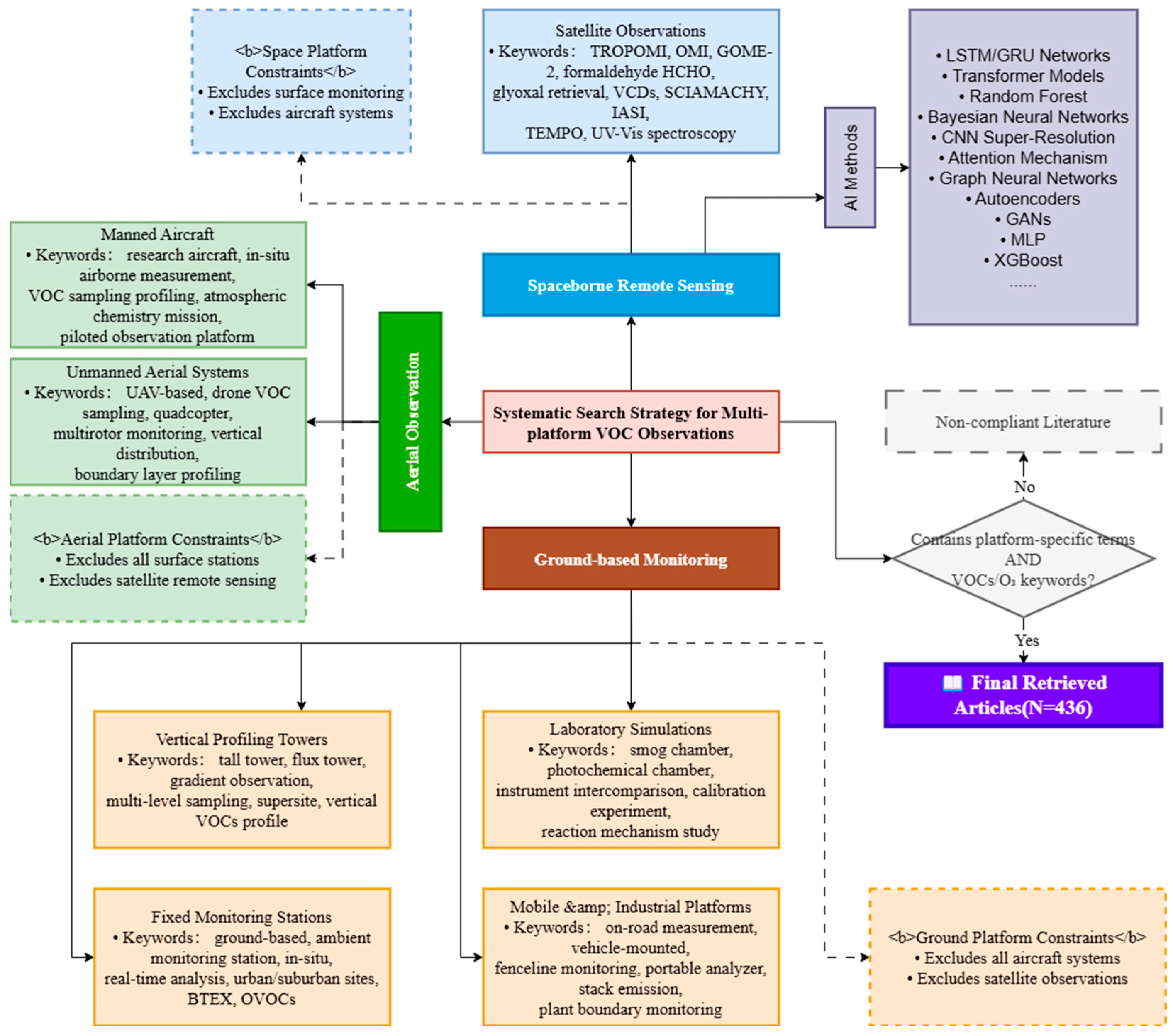
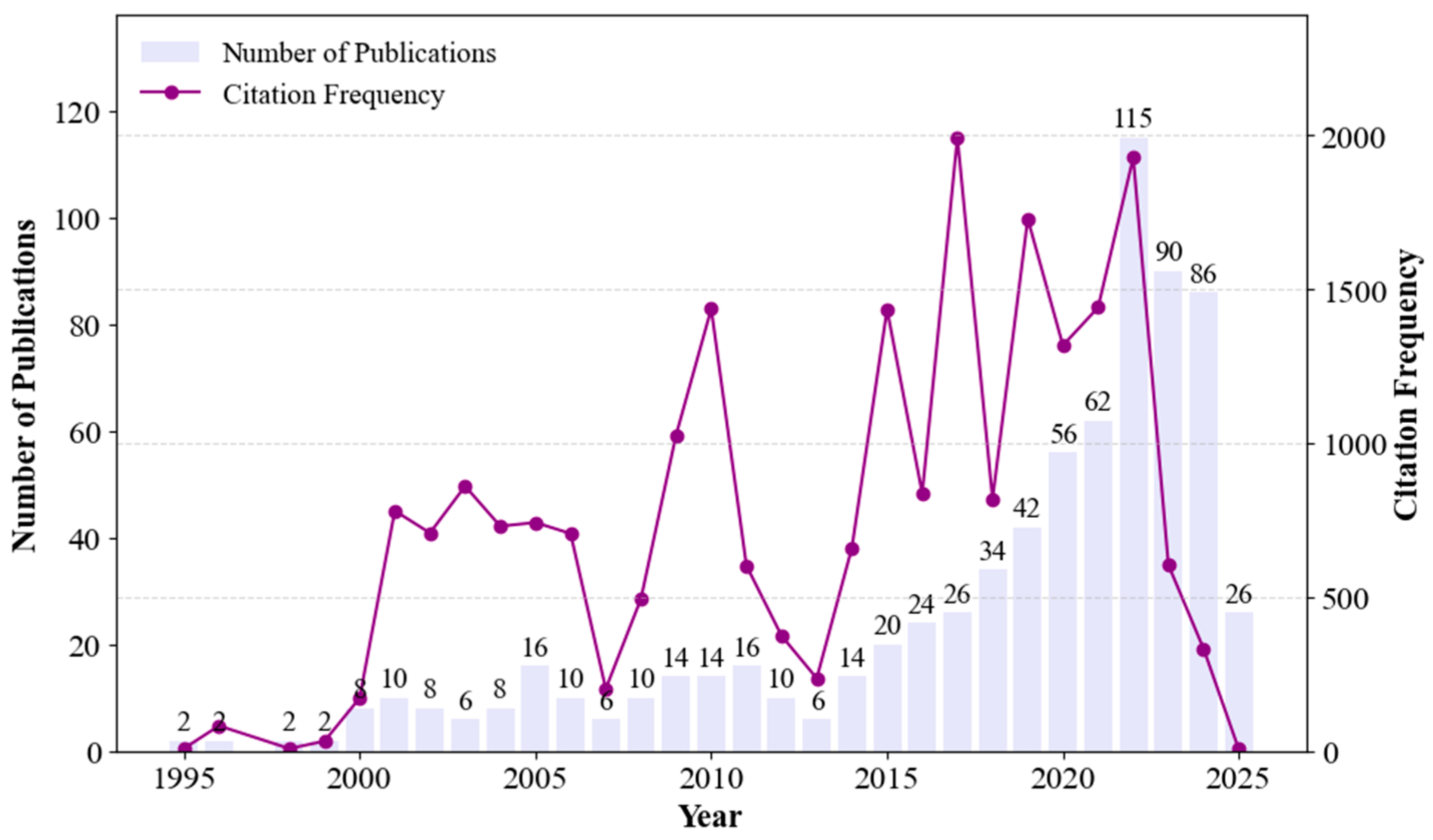
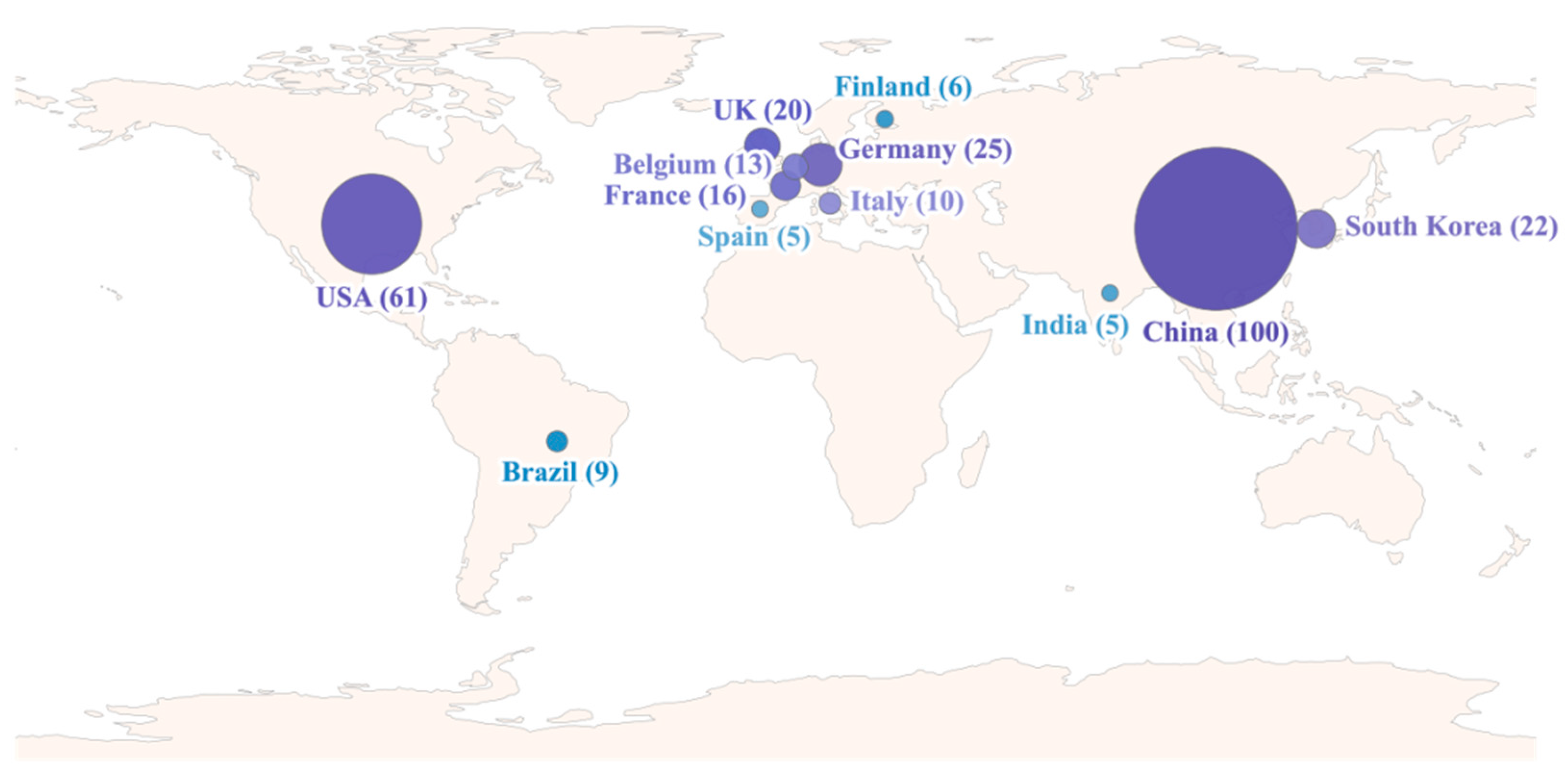
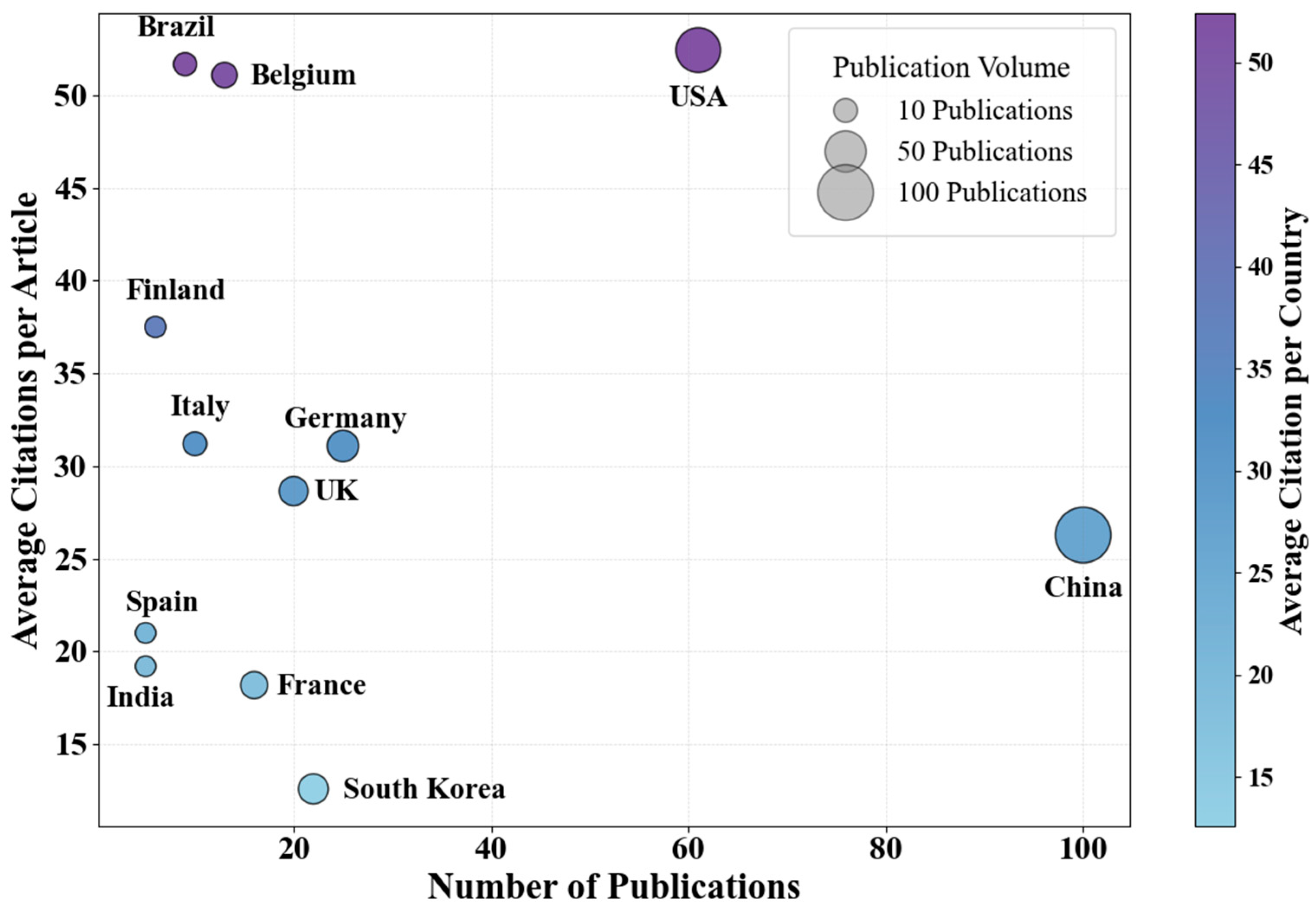
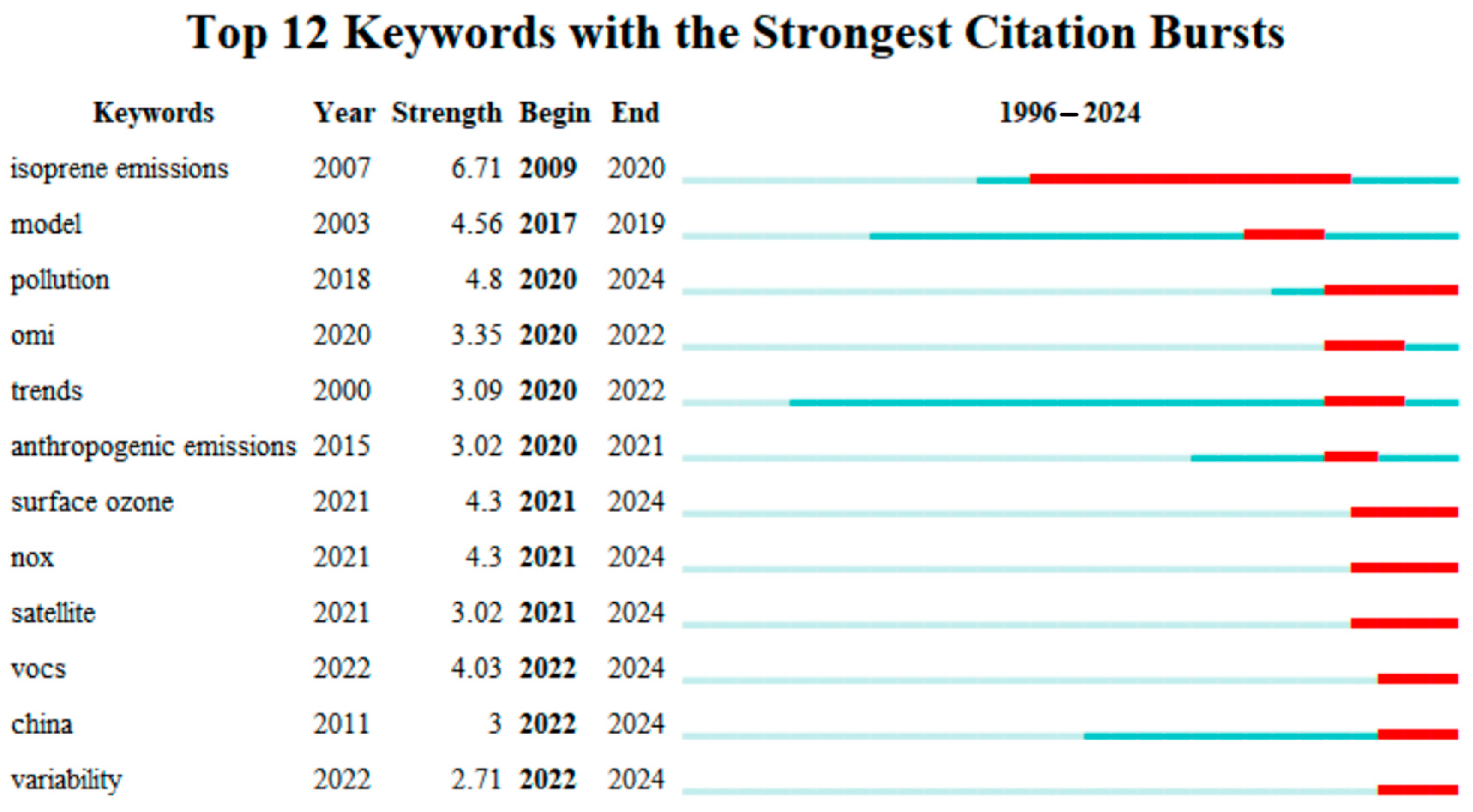
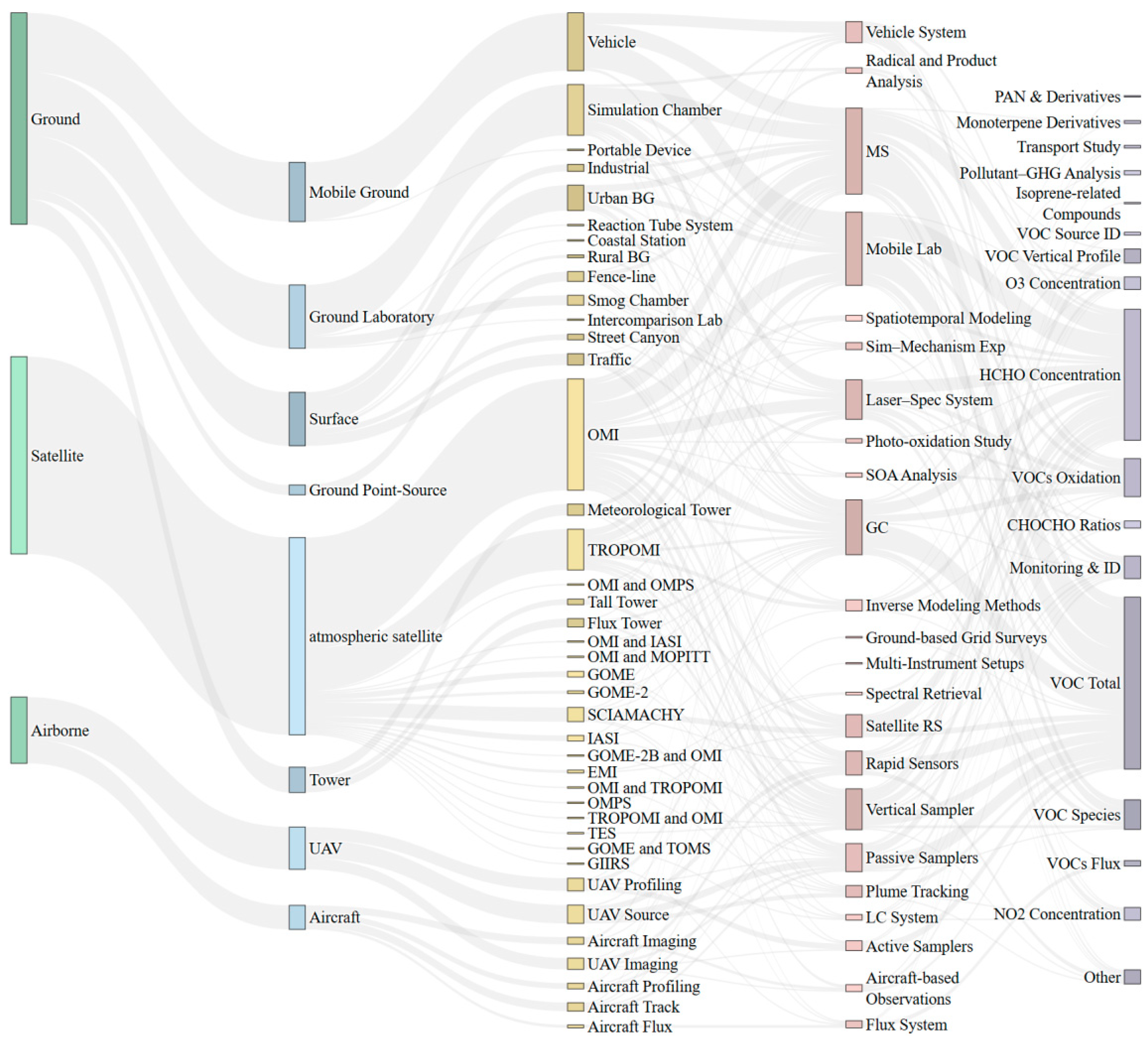

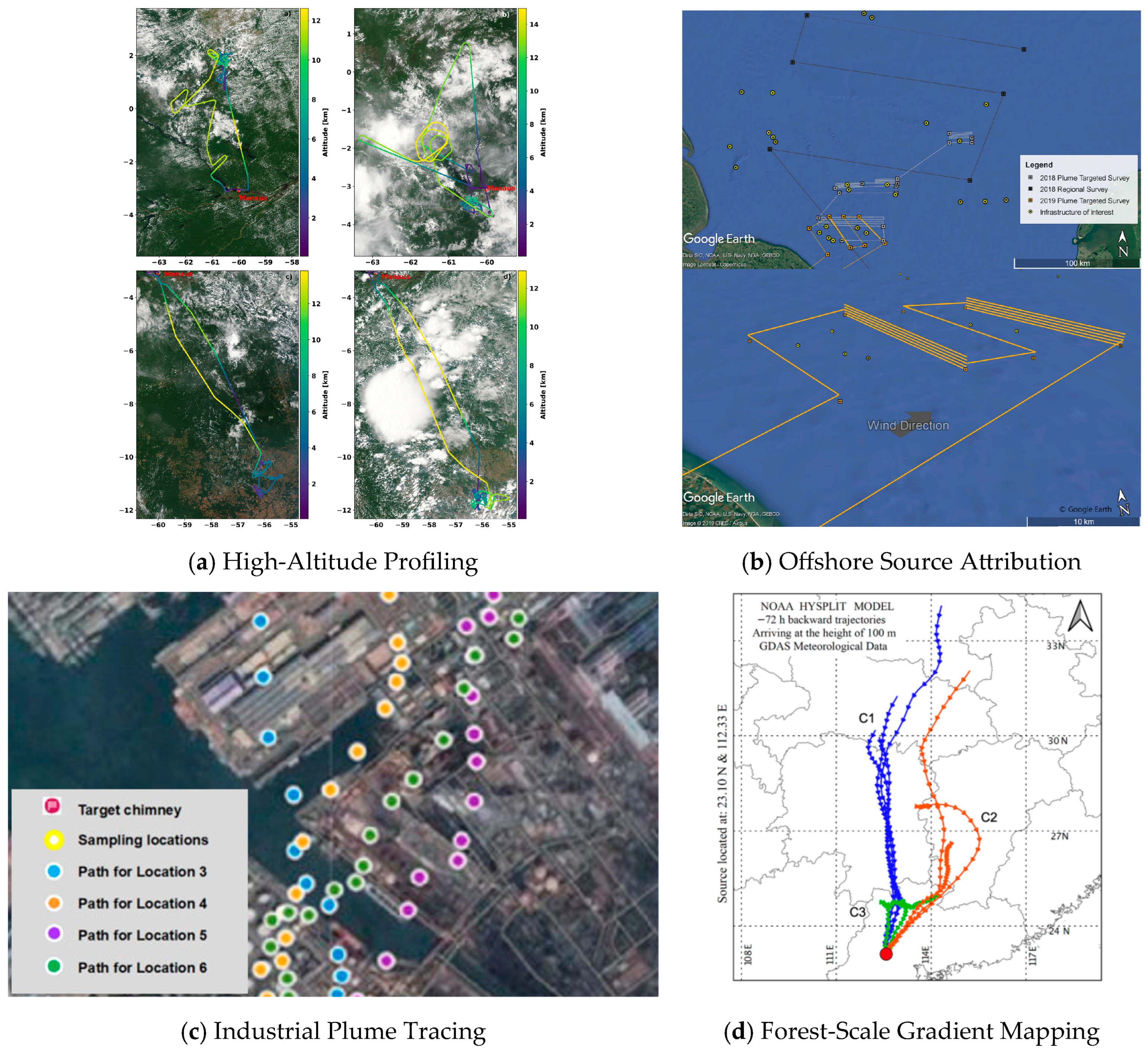
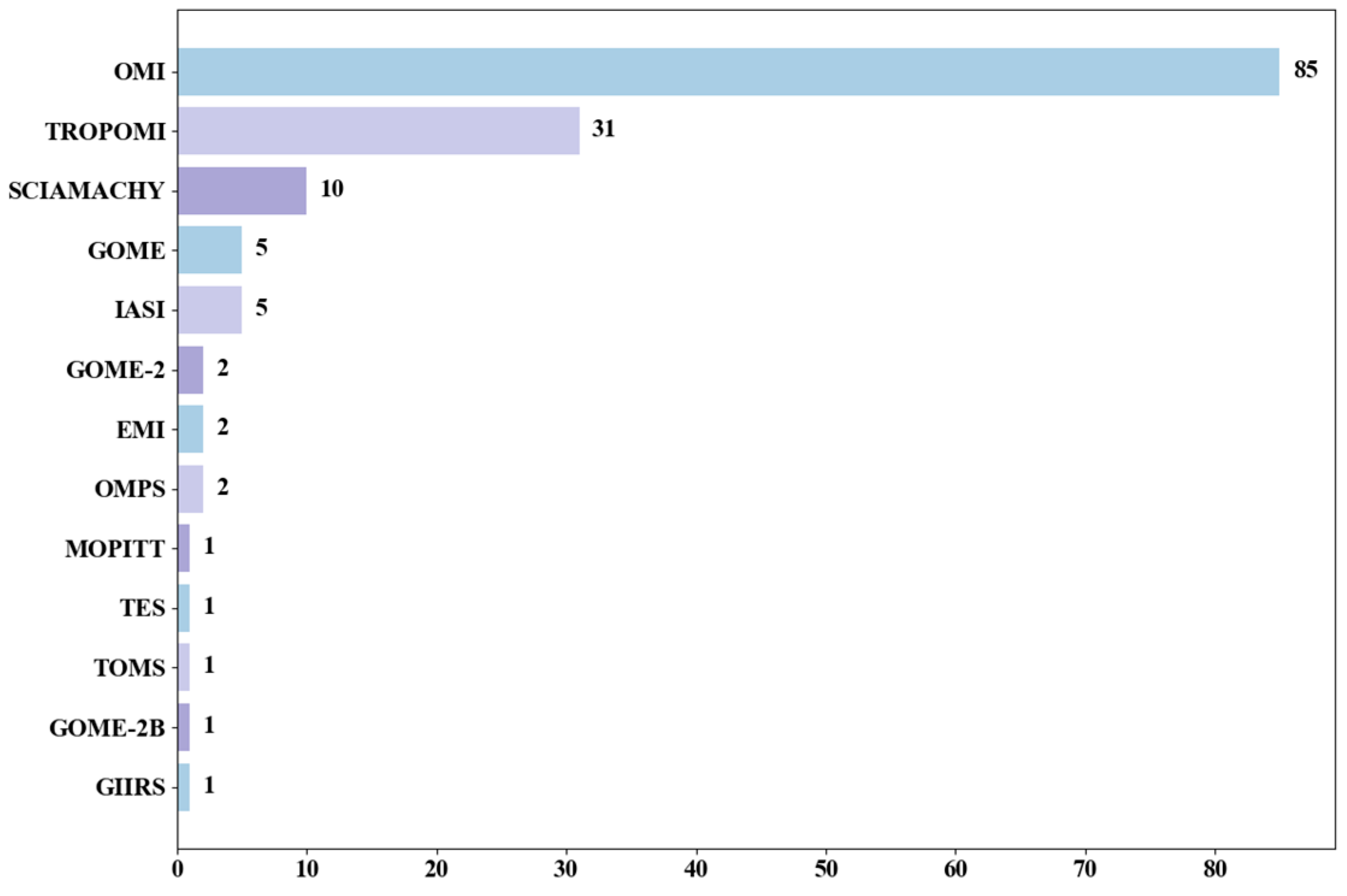
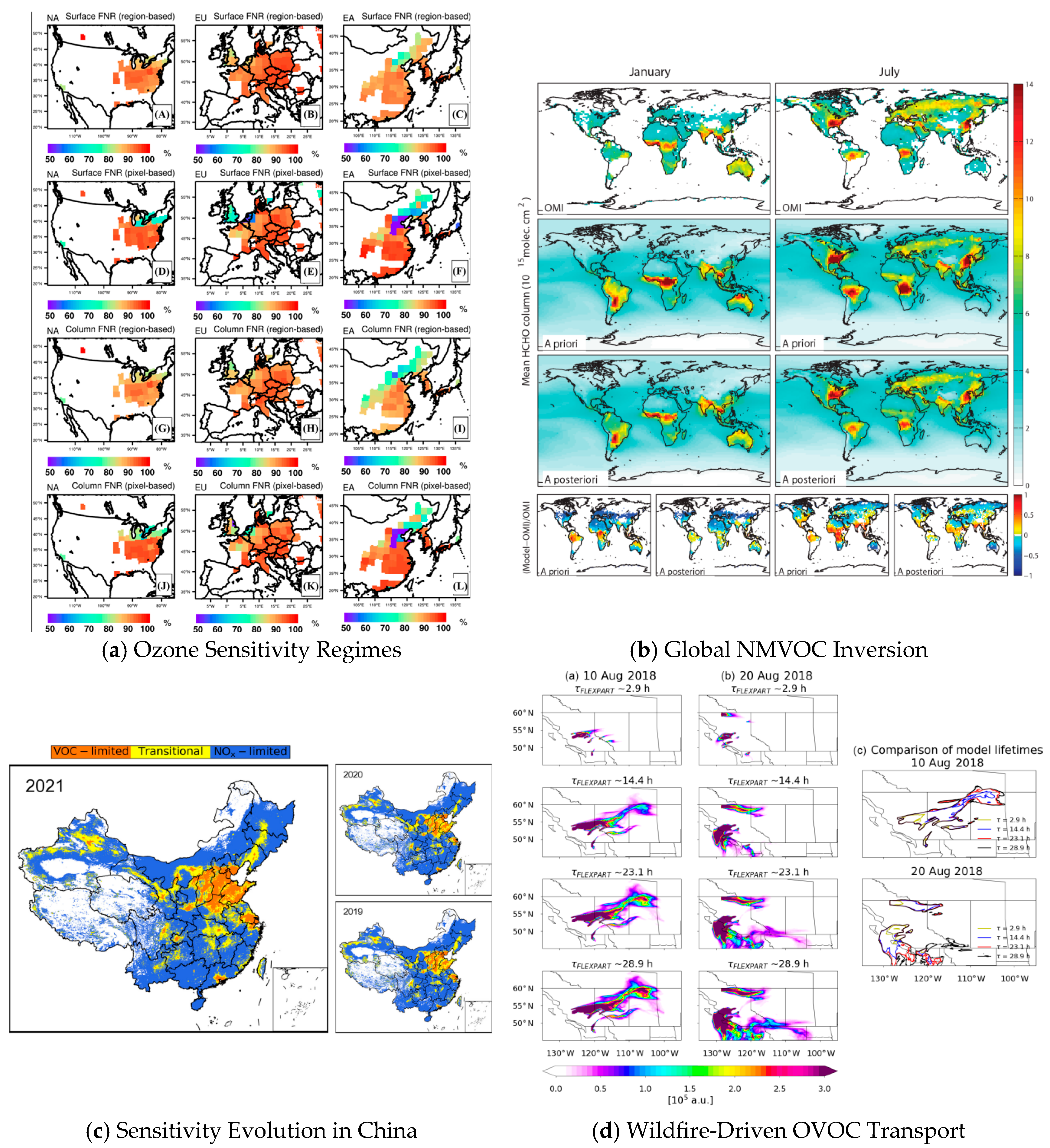
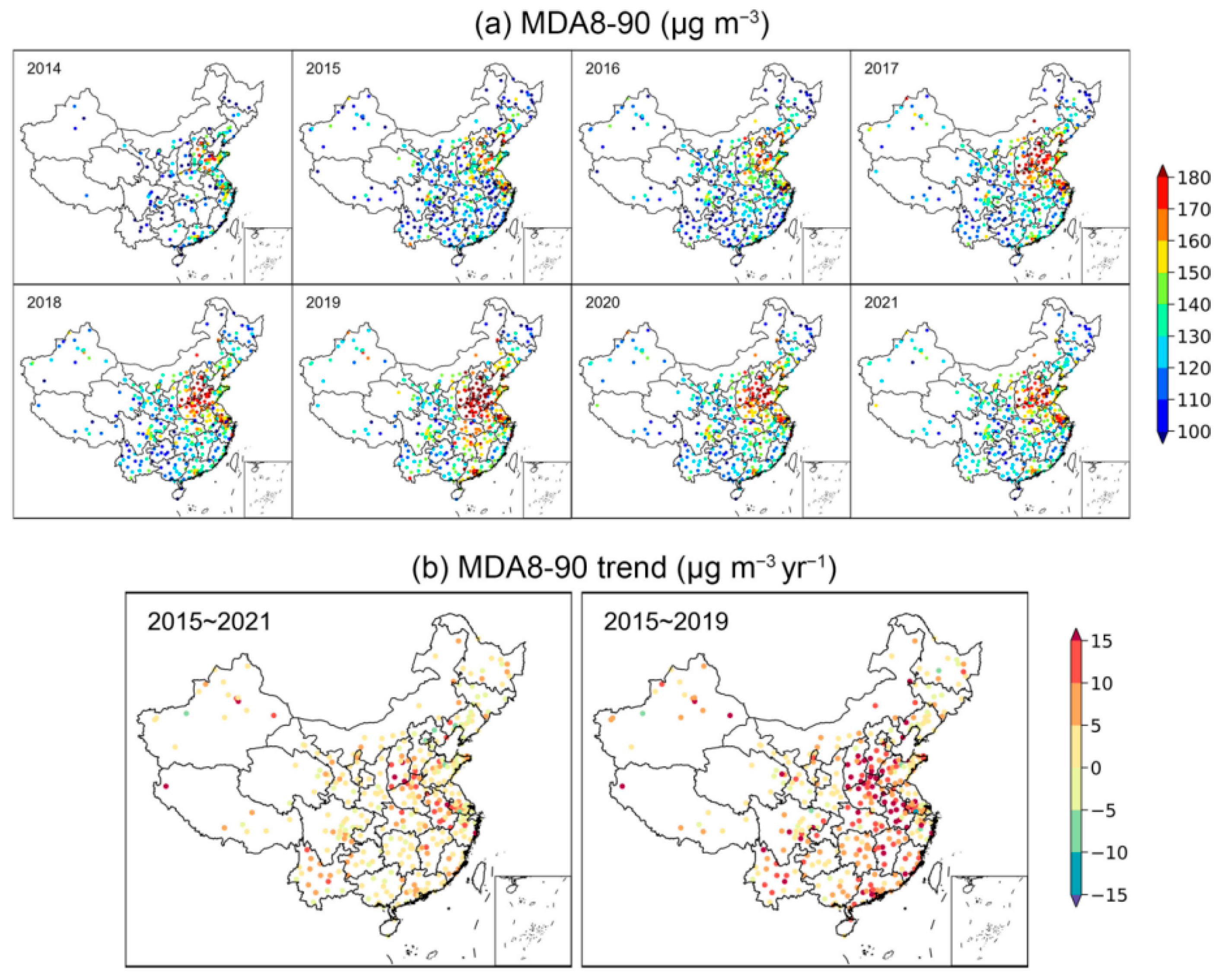

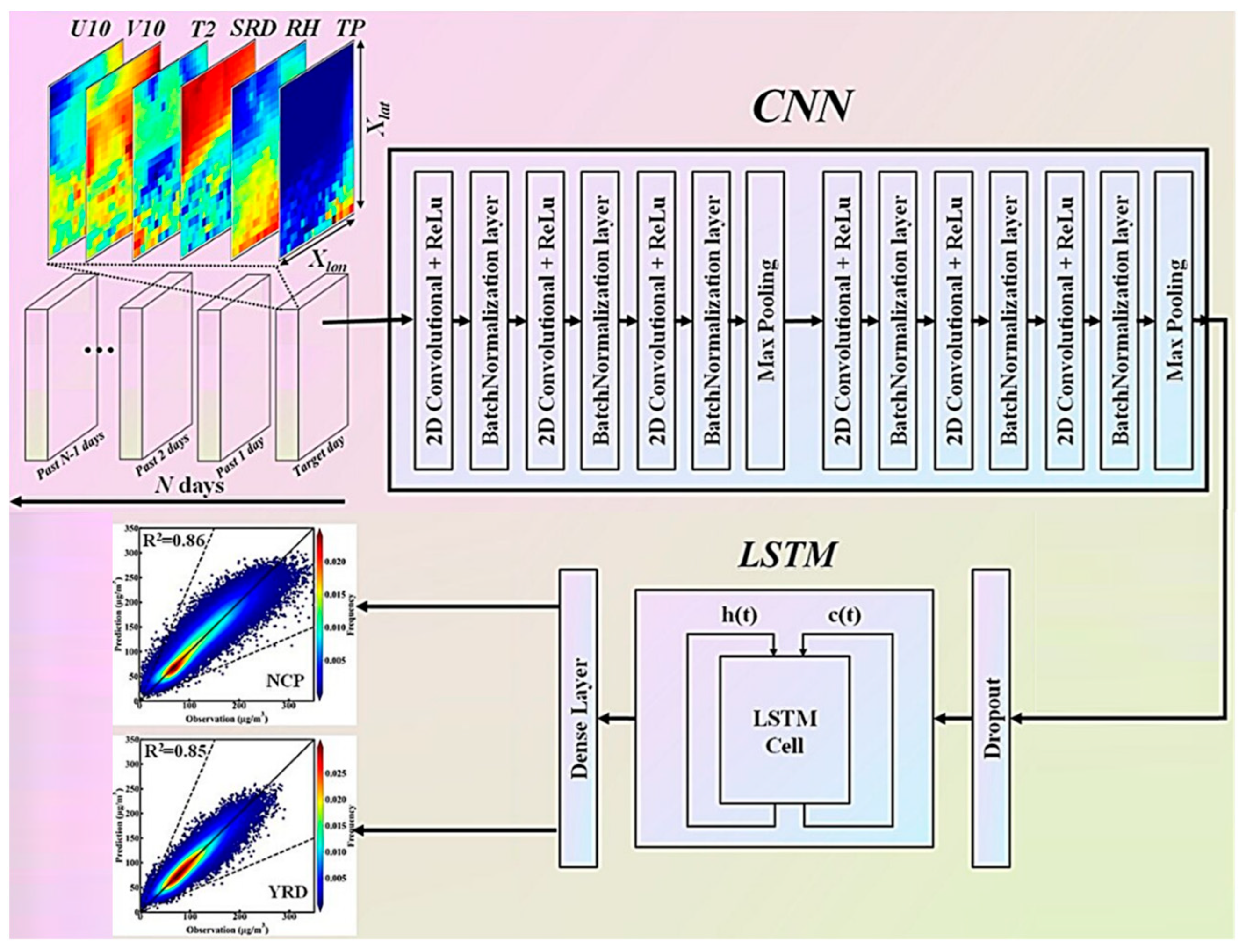
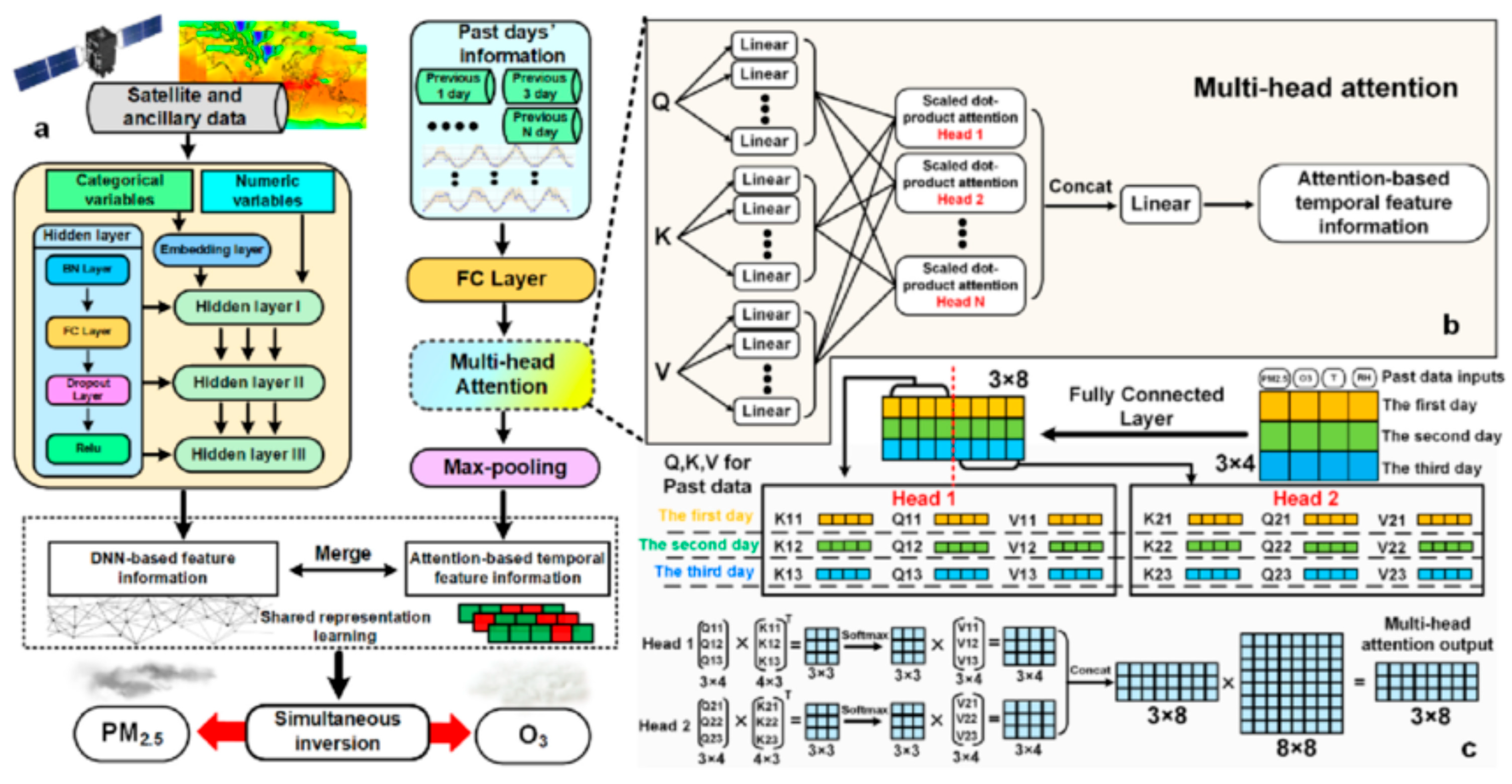
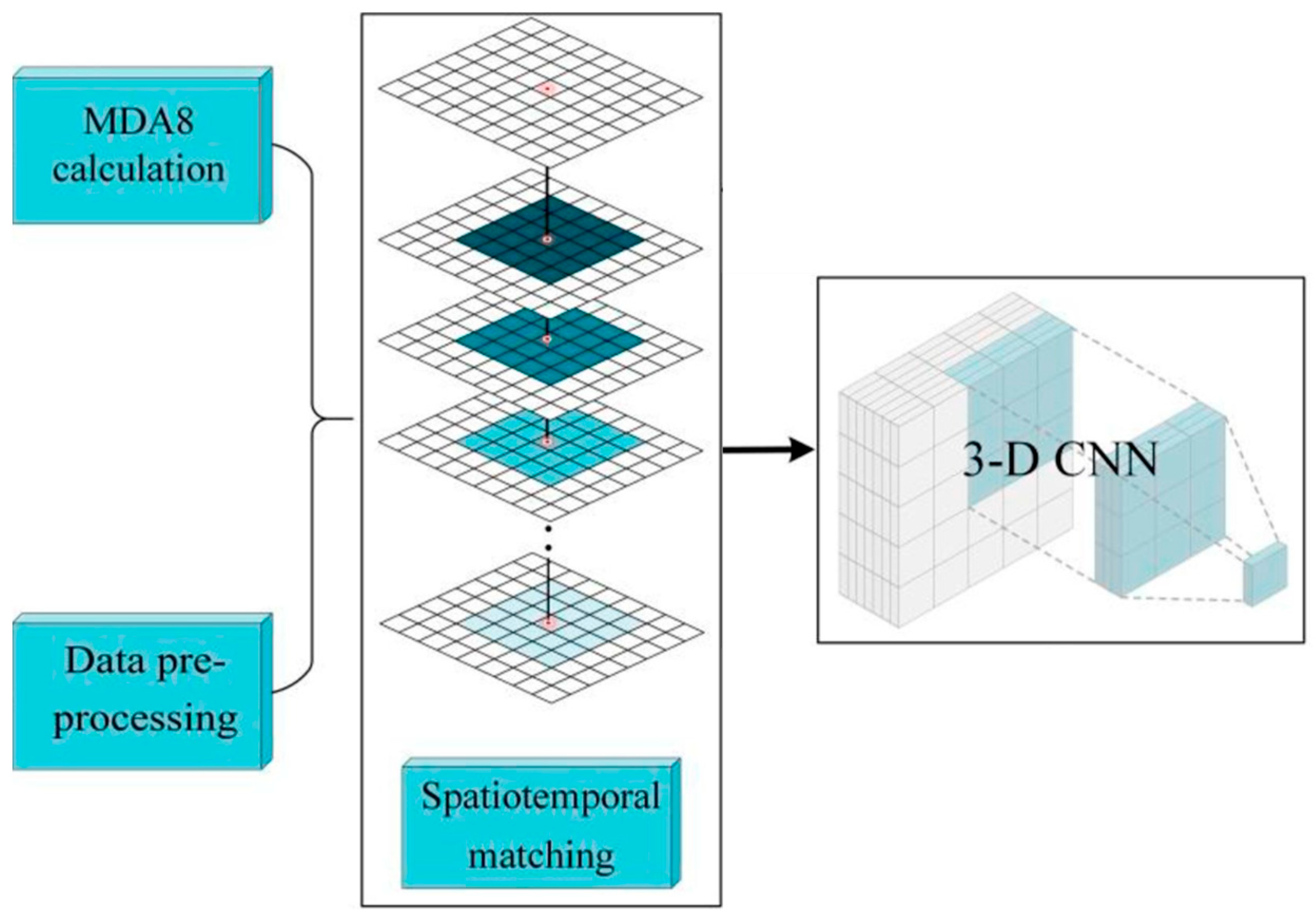
| Country | Frequency of Occurrence | Degree (Collaboration) | Betweenness Centrality | Citation Half-Life (HL) |
|---|---|---|---|---|
| China | 100 | 13 | 0.22 | 20.5 |
| USA | 61 | 19 | 0.41 | 21.5 |
| Germany | 25 | 15 | 0.21 | 16.5 |
| South Korea | 22 | 16 | 0.36 | 14.5 |
| UK | 20 | 8 | 0.11 | 12.5 |
| France | 16 | 15 | 0.25 | 13.5 |
| Belgium | 13 | 10 | 0.1 | 14.5 |
| Italy | 10 | 8 | 0.08 | 11.5 |
| Brazil | 9 | 4 | 0 | 13.5 |
| Finland | 6 | 1 | 0 | 21.5 |
| Spain | 5 | 7 | 0.01 | 10.5 |
| India | 5 | 8 | 0.11 | 15.5 |
| Observation Tier | Platform Category | Specific Configuration | Functional Role and Scientific Relevance |
|---|---|---|---|
| Ground-based Platform | Fixed Station | Urban background station | Captures long-term urban-scale VOC trends, supporting pollution assessment and policy feedback [13]. |
| Traffic station | Enables high-temporal-resolution analysis of vehicle emissions and their transient behavior [14]. | ||
| Rural background station | Represents regional transport background and secondary VOCs formation baselines [15]. | ||
| Industrial site station | Precisely identifies industrial sources and exposure zones, supporting emission verification [16]. | ||
| Coastal station | Reveals VOC flux and atmospheric transport dynamics at land–sea boundaries [17]. | ||
| Mobile Platform | Vehicle-based platform | Builds city-scale mobile monitoring networks for high-resolution spatial heterogeneity mapping [18]. | |
| Portable observation device | Provides flexible and rapid monitoring tools for hotspot detection and point-source screening [19]. | ||
| Point-Source Monitoring | Factory fence-line monitoring | Enables high-resolution monitoring of industrial boundary emissions for source strength estimation and accountability [20]. | |
| Chimney/stack emission sensor | Real-time monitoring of stack outlets is essential for emission control and compliance auditing [21]. | ||
| Source-oriented mobile survey | Combines mobile scanning with near-field detection to locate potential sources efficiently [2]. | ||
| Flux/Gradient Towers | Flux tower | Measures area VOC fluxes to support source–sink estimates and land–atmosphere exchange analysis [22]. | |
| Meteorological tower with gradient sampling | Constructs vertical profiles to study VOC transport and dilution in the boundary layer [23]. | ||
| Laboratory and Calibration Platform | Photochemical smog chamber | Simulates typical photochemical environments to study VOC oxidation chains and ozone formation [24]. | |
| Atmospheric simulation chamber | Controls initial conditions and reaction parameters to analyze secondary pollutant formation [25]. | ||
| Instrument intercomparison laboratory | Compares monitoring methodologies to promote observational consistency and standardization [26]. | ||
| Flow tube reactor/reaction cell | Used for single-pathway reactions and transient intermediate detection in mechanism validation [27]. | ||
| Airborne Platform | UAV Platform | UAV vertical profiling | Captures VOC vertical distribution within the boundary layer, addressing near-surface observational gaps [28]. |
| UAV remote sensing imaging | Provides high-resolution areal data for dispersion modeling and spatial pattern recognition [29]. | ||
| UAV source identification | Rapidly detects concentration anomalies near sources, supporting emission tracing and incident response [30]. | ||
| Manned Aircraft Platform | Aircraft trajectory observation | Collects high-frequency samples along flight paths to analyze long-range transport and evolution [31]. | |
| Aircraft flux observation | Measures VOC flux across transects to estimate regional budgets and boundary-layer dynamics [32]. | ||
| Aircraft remote sensing imaging | Acquires high-altitude wide-area imagery for model validation and pollution mapping [31]. | ||
| Aircraft vertical profiling | Constructs VOC profiles from the surface to mid-troposphere for model constraint and mechanism analysis [33]. | ||
| Satellite-based Platform | Satellite Platform | Core Operational Satellites (e.g., TROPOMI, OMI, and IASI) | Provide high-resolution global retrievals of VOC precursors (e.g., HCHO and NO2), forming the backbone for emission assessment, trend analysis, and atmospheric model assimilation [34,35,36]. |
| Specialized Instruments (e.g., TES, GIIRS, EMI, MOPITT, and OMPS) | Address advanced tasks such as vertical profiling, hyperspectral inversion, combustion source tracking, and supplementary column observations of trace gases [34,37,38,39]. | ||
| Legacy Observation Missions (e.g., GOME, GOME-2, SCIAMACHY, and TOMS) | Established foundational VOC and ozone remote sensing datasets, enabling cross-generational continuity and long-term atmospheric change analysis [40,41]. |
| Dimension | Manned Aircraft | Unmanned Aerial Vehicle (UAV) |
|---|---|---|
| Operational Altitude | Up to 15 km (troposphere) | <500 m (near-surface, canopy level) |
| Typical Duration | 4–10 h (long-range campaigns) | 0.5–1 h (battery-limited) |
| Payload Capacity | High (full-size GC–MS, PTR–MS, offline trays) | Limited (mini samplers, sensors) |
| Spatial Resolution | Moderate–high (regional plumes, stacked paths) | Very high (local gradients, point sources) |
| Application Focus | Biomass plumes, marine, regional transport | Industrial tracing, canopy fluxes, emergency response |
| Strengths | Vertical profiling, long-distance coverage | Low-altitude flexibility, near-field resolution |
| Article Title | Year | Authors | Affiliations | Publication /Source Titles | Cited Reference Count | Contribution |
|---|---|---|---|---|---|---|
| Ozone production and hydrocarbon reactivity in Hong Kong, Southern China | 2007 | Zhang, J et al. [6]. | Hong Kong Polytechnic University | Atmospheric Chemistry and Physics | 129 | OBM trajectory analysis coupled with δCO/δNOy tracer diagnostics quantified that 50% of extreme O3 episodes (>100 ppbv) resulted from Guangdong-sourced precursors, while VOC-HONO constraints in the box model resolved 50–100% local photochemical amplification. |
| Global tropospheric ozone modeling: Quantifying errors due to grid resolution | 2006 | Wild, O et al. [84]. | Japan Agency for Marine-Earth Science and Technology (JAMSTEC) | Journal of Geophysical Research: Atmospheres | 104 | CTM multi-resolution experiments (T21–T106) exposed artifactual O3 overproduction (up to +27% at 5.6°) from spatiotemporal smearing of NOx gradients, demanding sub-120 km grids for fidelity in nonlinear chemistry. |
| The effects of lightning-produced NOx and its vertical distribution on atmospheric chemistry: sensitivity simulations with MATCH-MPIC | 2005 | Labrador, LJ et al. [90]. | Max Planck Society | Atmospheric Chemistry and Physics | 86 | MATCH-MPIC CTM parametrization established free-tropospheric lightning NOx injection (98%) as critical for accurate O3-OH-HNO3 covariance—elevating trans-Pacific NOy export by 24–43% versus convective schemes. |
| Atmospheric oxidation capacity and ozone pollution mechanism in a coastal city of southeastern China: analysis of a typical photochemical episode by an observation-based model | 2022 | Liu, TT et al. [86]. | Chinese Academy of Sciences | Atmospheric Chemistry and Physics | 79 | OBM-MCM radical tracking decoupled daytime/nighttime AOC drivers (HONO: 33% ROx initiation), with CTM sensitivity runs confirming VOC-limited O3 suppression under suppressed NOx scenarios. |
| Global chemical transport model study of ozone response to changes in chemical kinetics and biogenic volatile organic compounds emissions due to increasing temperatures: Sensitivities to isoprene nitrate chemistry and grid resolution | 2009 | Ito, A et al. [91]. | Japan Agency for Marine-Earth Science and Technology (JAMSTEC) | Journal of Geophysical Research: Atmospheres | 74 | CTM-simulated ΣANs-O3 correlations demonstrated that NOx recycling parametrization governs BVOC–O3 climate sensitivity as profoundly as grid resolution (+40 Tg burden uncertainty). |
| Seasonal variability of secondary organic aerosol: A global modeling study | 2004 | Lack, DA et al. [92]. | Queensland University of Technology (QUT) | Journal of Geophysical Research: Atmospheres | 71 | CTM intercomparison (bulk-yield vs. partitioning algorithms) exposed oxidant-driven SOA biases over biomass-burning regions, reducing global flux uncertainty from 39% to mechanistically resolved regimes. |
| The Mediterranean summertime ozone maximum: global emission sensitivities and radiative impacts | 2013 | Richards, NAD et al. [93]. | University of Leeds | Atmospheric Chemistry and Physics | 67 | TOMCAT CTM emission-tagging isolated near-surface O3 sensitivity to local NOx (9× > global sources) versus Asian-sourced UT O3 radiative dominance—reconciling TES/GOME-2 column discrepancies. |
| Parameterization of secondary organic aerosol mass fractions from smog chamber data | 2008 | Stanier, CO et al. [94]. | University of Iowa | Atmospheric Environment | 59 | Derived CTM-ready surrogate-VOC basis set with fixed saturation concentrations (C = 0.1–103 μg/m3), eliminating enthalpy-driven volatility uncertainties in aerosol modules. |
| Sensitivity to grid resolution in the ability of a chemical transport model to simulate observed oxidant chemistry under high-isoprene conditions | 2016 | Yu, KR et al. [85]. | Harvard University | Atmospheric Chemistry and Physics | 48 | GEOS-Chem 0.25° simulations resolved mesoscale NOx-isoprene segregation, suppressing high-NOx pathway errors by 5% and rectifying SEAC4RS HCHO validation failures. |
| Comprehensive Insights Into O3 Changes During he COVID-19 From O3 Formation Regime and Atmospheric Oxidation Capacity | 2021 | Zhu, SQ et al. [87]. | Fudan University | Geophysical Research Letters | 48 | Source attribution CTM decoupled lockdown O3 surges into AOC-enhanced local chemistry (60%) vs. imported pollution, triggering OBM-validated VOC→NOx-limited transition. |
Disclaimer/Publisher’s Note: The statements, opinions and data contained in all publications are solely those of the individual author(s) and contributor(s) and not of MDPI and/or the editor(s). MDPI and/or the editor(s) disclaim responsibility for any injury to people or property resulting from any ideas, methods, instructions or products referred to in the content. |
© 2025 by the authors. Licensee MDPI, Basel, Switzerland. This article is an open access article distributed under the terms and conditions of the Creative Commons Attribution (CC BY) license (https://creativecommons.org/licenses/by/4.0/).
Share and Cite
Zhu, X.; Wang, H.; Han, Y.; Zhang, D.; Liu, S.; Zhang, Z.; Liu, Y. Reconstructing the VOC–Ozone Research Framework Through a Systematic Review of Observation and Modeling. Sustainability 2025, 17, 7512. https://doi.org/10.3390/su17167512
Zhu X, Wang H, Han Y, Zhang D, Liu S, Zhang Z, Liu Y. Reconstructing the VOC–Ozone Research Framework Through a Systematic Review of Observation and Modeling. Sustainability. 2025; 17(16):7512. https://doi.org/10.3390/su17167512
Chicago/Turabian StyleZhu, Xiangwei, Huiqin Wang, Yi Han, Donghui Zhang, Senhao Liu, Zhijie Zhang, and Yansheng Liu. 2025. "Reconstructing the VOC–Ozone Research Framework Through a Systematic Review of Observation and Modeling" Sustainability 17, no. 16: 7512. https://doi.org/10.3390/su17167512
APA StyleZhu, X., Wang, H., Han, Y., Zhang, D., Liu, S., Zhang, Z., & Liu, Y. (2025). Reconstructing the VOC–Ozone Research Framework Through a Systematic Review of Observation and Modeling. Sustainability, 17(16), 7512. https://doi.org/10.3390/su17167512





